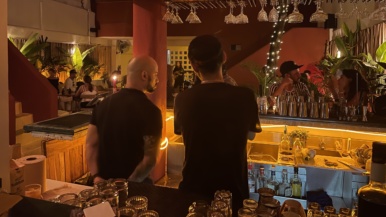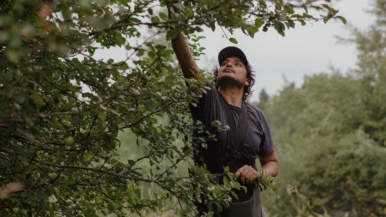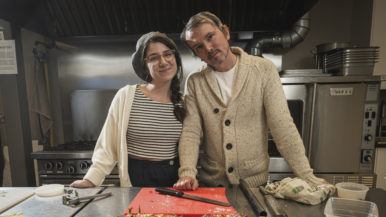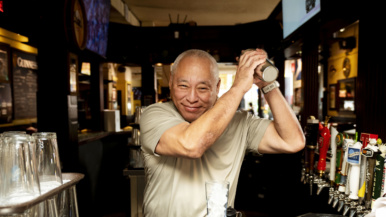When I broke my back, I knew I’d never walk again. That didn’t mean I couldn’t race

One beautiful October morning in 2008, my friend Eric and I went for a bike ride. At the time, I was a marketing manager at Microsoft and living in Oakville, so we hit the trails near Bronte Creek, snaking through the woods. After an hour or so, we came upon a makeshift ramp on a fallen tree, about halfway down a hill. Never one to refuse a challenge, I coasted toward the end of the ramp, did a bunny hop and flew into the air. I landed on my front wheel and waited for the back wheel to touch down. It didn’t. The bike tipped forward, my face rammed into the dirt, my legs vaulted over the rest of my body, and I heard my back pop. I realized I couldn’t feel my legs.

Neither of us had a phone, so Eric biked out of the forest to get help. My back ached and my body shivered as I stared at the sky. I thought of my wife, Sabrina, and our daughters, four-year-old Chloe and two-year-old Zara, and how I might never dance at their weddings.
Twenty-five minutes later, the paramedics hiked in. They cut off my clothes and prodded my lower body, asking what I could feel. Feet? No. Thighs? No. Stomach? No. Chest? Yes. They strapped me to a stretcher and hauled me out of the bush on foot. A chopper flew me to a hospital in Hamilton.
I spent the next several hours drifting in and out of consciousness. That evening, I woke up in a hospital bed and learned the extent of my injury. Two vertebrae in my lower back had jammed on top of each other, paralyzing me from the chest down. Surgeons nudged them back into place and inserted two titanium rods above and below the break in my spine. I would never walk again, but the doctor told me I was lucky to be alive.
The next few days were a blur of visits from family and friends. I tried to put on a brave face, but I was terrified. My independence was gone. I needed a nurse just to turn my body in bed. I nearly fainted if I tried to sit up. I had to learn to manage my bowel and bladder. When the hospital chaplain visited me, she acted as though my life had been ruined. I asked her to leave; I didn’t want her pity.
My daughters were too young to understand what had happened, but Sabrina and I quickly learned what my injury meant. With one bad decision, I’d changed our lives forever. I’d have to live in a wheelchair and adjust almost every part of my daily life. If Sabrina was concerned, she never let it show. She made me believe everything was going to be okay.
After three weeks in hospital, I transferred to a rehab centre at Bayview and Eglinton. Physically, I was making progress—lifting weights, getting dressed on my own and wheeling myself around. By the time I returned home in January 2009, we had replaced the rugs with hardwood floors, widened the doorways and installed an elevator. I modified my car so I could drive with just my hands. Sabrina, who had put her career on hold to care for our kids, started doing freelance communications work. I returned to my job a couple of days a week and did my best to help around the house. I longed for the classic dad stuff: cutting the grass, carrying my kids to bed, playing soccer, going to the beach (we tried; it was a sandy nightmare). It killed me to watch my friends throw my giggling daughters in the air. That was my job.
One day, I was watching TV coverage of the Ironman World Championship, a triathlon in Kona, Hawaii. I saw a segment about Ricky James, a para-triathlete who had broken his back in a motocross accident. I couldn’t believe it: he swam almost four kilometres, cycled 180 on a hand bike and wheeled 42 in a chair. I wondered if I could pull it off.
In 2011, three years after my accident, I set a goal: become the first Canadian paraplegic to complete an Ironman. I spent countless hours at the gym. I learned how to swim with just my arms. I spent days in my handcycle and racing wheelchair, building my endurance and speed. As my leg muscles shrank, my upper body bulked up. Sabrina and I trained together, and, by 2012, we finished our first half-Ironman. Then we did another. Then another. In 2016, I became one of four male paraplegics to qualify for Kona.
On race day, helicopters zoomed overhead and the crowd was electric. I completed the swim in third but fell to last place during the bike. As I lay on my back in my hand-bike for more than eight hours, my skin fried in the sun. But my fate improved: during the wheelchair leg of the race, I moved into third place, then second. As I approached the finish, the spectators roared. I took second place in my division. I went straight to the hospital to get treated for dehydration. It cost me $10,000, but, in the moment, I didn’t care. I’d done it.

When I returned home, I figured that, if I could do an Ironman, I could do anything. Of course, reality crept back in. I remembered that it’s still difficult for me to pick up milk at the corner store. But my life is good: I work out five times a week, play guitar and spend more time with my family than I ever did before my accident. I still won’t be able to dance with my daughters at their weddings, but that’s okay. I hope watching their dad succeed despite all the challenges has done more for them than one little dance ever could.
Robert Buren is a para-athlete and public speaker in Oakville.
Email submissions to memoir@torontolife.com





